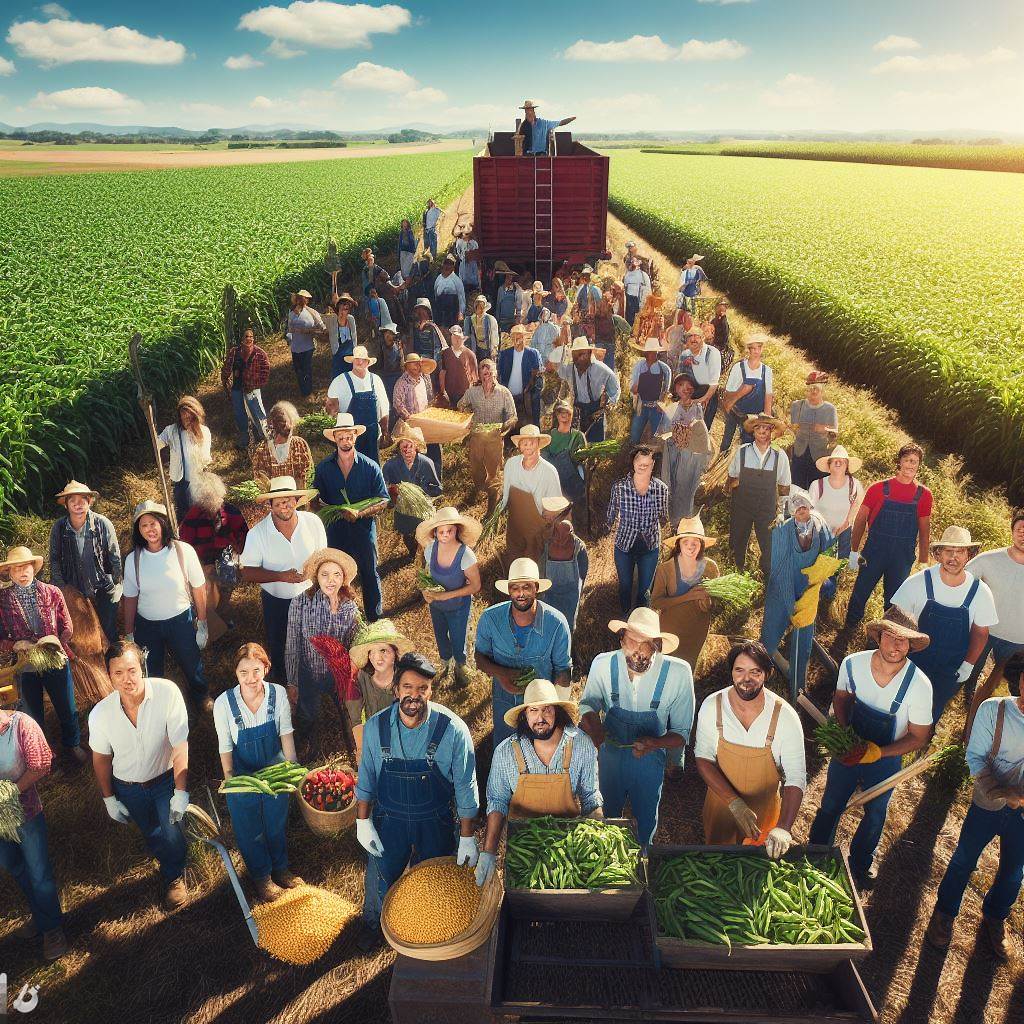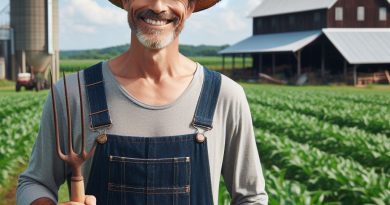Behind the Scenes: Visits to Local Farms
Last Updated on March 2, 2024
Introduction
At first glance, farms may appear as idyllic scenes from a storybook.
Rolling green pastures, animals grazing peacefully, and bountiful crops reaching towards the sky.
However, there is much more to local farms than meets the eye.
Through our visits to local farms, we aim to uncover the hidden realities and showcase the hard work that goes into producing the food we consume.
These visits provide an opportunity for us to learn about sustainable farming practices, animal welfare, and the importance of supporting local agricultural communities.
By getting a glimpse behind the scenes, we can gain a deeper understanding of the challenges faced by farmers and appreciate their dedication to feeding our communities.
During our visits, we will explore the daily routines of farmers, witnessing firsthand the early mornings, long hours, and physical labor required to maintain a successful farm.
We will also have the chance to interact with farm animals, understanding the importance of their welfare and the impact it has on the quality of the products we enjoy.
Additionally, we will delve into the intricate process of cultivating crops, from planting seeds to harvesting, and learn about the various techniques used to ensure successful yields.
Through these experiences, we hope to inspire readers to support local farms, appreciate the value of sustainable agriculture, and make more informed decisions about the food they consume.
Join us as we embark on this behind-the-scenes journey into the heart of local farming, where nature, hard work, and dedication converge to sustain our communities and nourish our bodies.
Stay tuned for exciting farm adventures in the upcoming sections!
Benefits of Visiting Local Farms
Visiting local farms offers numerous benefits that go beyond a simple outing.
These visits provide an educational experience that allows individuals to learn about different farming practices and the importance of sustainable agriculture.
The educational aspect
One of the key benefits of visiting local farms is the educational aspect.
People have the opportunity to witness firsthand the hard work and dedication that goes into running a farm.
By observing the farmers in action, visitors can learn about the various techniques, equipment, and methods employed in farming.
Furthermore, these visits contribute to a deeper understanding of sustainable agriculture practices.
Sustainable farming is essential for preserving natural resources and minimizing negative environmental impacts.
By visiting local farms, individuals can see how farmers prioritize sustainable practices such as crop rotation, organic pest control, and responsible water management.
The opportunity to support local farmers
Local farm visits also provide an opportunity to support local farmers.
By buying produce directly from the source, consumers can ensure that their money goes directly to the farmers, rather than middlemen or large corporations.
This provides farmers with a fair income and encourages them to continue their agricultural pursuits.
In addition to supporting farmers, buying directly from local farms also guarantees fresher and higher-quality products.
When produce doesn’t have to travel long distances, it retains more nutrients and flavor.
Consumers can enjoy the taste of freshly harvested fruits and vegetables, which in turn promotes healthier eating habits.
Supporting local farmers creates a sense of community and strengthens local food systems.
By establishing connections with farmers, consumers develop a better understanding of where their food comes from.
This knowledge helps foster trust and encourages a stronger bond between producers and consumers.
Moreover, contributing to the local economy is another significant benefit of visiting local farms.
By purchasing directly from farms, consumers help to sustain rural communities.
This support not only aids farmers but also benefits other local businesses that rely on the agricultural industry.
It strengthens the entire local economy and ensures the viability and vitality of rural areas.
Overall, visiting local farms offers both educational and supportive advantages.
These visits allow individuals to learn about different farming practices and gain a better understanding of sustainable agriculture.
By buying directly from local farmers, people can support their efforts, enjoy fresher produce, and contribute to the flourishing of local economies.
Read: Organic vs. Local: A Detailed Comparison
Planning a Visit
Planning a visit to a local farm can be an exciting and educational experience for individuals of all ages.
Whether you are interested in learning more about sustainable farming practices or simply want to enjoy the fresh air and beautiful scenery, taking a trip to a nearby farm can provide a unique and rewarding experience.
However, before packing your bags and heading out, it’s important to plan your visit carefully to ensure a smooth and enjoyable trip.
Research local farms in the area
The first step in planning a visit to a local farm is to research the farms available in the area.
There are various online resources and directories that can provide comprehensive information about nearby farms.
Take the time to explore these resources and make a list of potential farms to visit based on your interests and the programs they offer.
When conducting your research, focus on finding farms that offer visitor programs or educational opportunities.
These types of farms often have designated areas for visitors and provide guided tours or activities.
This allows you to learn more about the farm’s operations and engage in hands-on experiences, making your visit more informative and enjoyable.
Consider the timing and accessibility
Once you have identified potential farms to visit, it’s important to consider the timing and accessibility of each farm.
Check if the farm has a visiting schedule or specific opening hours.
Some farms may only allow visitors on certain days or during specific time slots.
Plan your visit accordingly to ensure that you don’t arrive at a closed farm.
In addition to timing, evaluate the distance to the farm and the transportation options available.
Consider how long it will take to reach the farm and whether you need to rely on public transportation or have access to a car.
If the farm is too far or transportation options are limited, you may need to reconsider your choice or explore alternative means of reaching the destination.
By conducting thorough research and considering logistical factors, you can plan a successful visit to a local farm.
Remember to check for any additional requirements or restrictions imposed by the farm, such as pre-booking or specific health and safety guidelines.
With proper planning, you can make the most out of your farm visit and create lasting memories of a unique agricultural experience.
Read: Community Supported Agriculture (CSA) 101

Delve into the Subject: Spring Greens: Seasonal Eating Made Easy
What to Expect During a Visit
When planning a visit to a local farm, it is essential to have an idea of what to expect.
This section will provide an overview of typical farm activities and discuss the potential for guided tours or self-guided exploration.
Overview of typical farm activities
1. Touring the fields and crops
Visitors to local farms can expect to take a tour of the fields and crops.
This is an excellent opportunity to learn about various types of crops, like vegetables, fruits, or grains.
Farmers often provide insightful information about the cultivation and care of these crops, giving visitors a deeper understanding of the farm’s practices.
2. Interacting with farm animals
Farms are home to a wide range of animals, such as cows, chickens, goats, and pigs.
During a visit, visitors can interact with these farm animals, feeding them, petting them, and even learning about their daily routines.
It’s a chance to connect with nature and experience the joys of being around animals.
3. Participating in hands-on activities like milking cows or harvesting
For those looking for a more immersive farm experience, hands-on activities are often available.
These activities may include milking cows, feeding livestock, or harvesting crops.
By participating in these activities, visitors can gain a firsthand perspective on the hard work and dedication required to run a successful farm.
Discussion about the potential for guided tours or self-guided exploration
1. Highlight the benefits of learning from farm staff
Guided tours led by knowledgeable farm staff can be an excellent way to learn about farming practices and the various aspects of a working farm.
Farm staff can provide valuable insights, answer questions, and share personal stories, enhancing the overall learning experience.
Visitors can truly delve into the inner workings of the farm with experts guiding the way.
2. Advantages of exploring at your own pace and curiosity
On the other hand, self-guided exploration offers the freedom to explore the farm at one’s own pace and pursue specific areas of interest.
Visitors can spend more time observing certain activities or seeking answers to their unique questions.
This approach allows for a more personalized experience and encourages a sense of curiosity and discovery.
In a nutshell, a visit to a local farm promises a rich and informative experience.
With activities like touring the fields, interacting with animals, and participating in hands-on tasks, visitors can gain a deeper understanding of farming practices.
Whether opting for guided tours or self-guided exploration, there are plenty of opportunities to learn, engage, and appreciate the beauty of a working farm.
Read: Cooking Tips: From Farm Produce to Plate
Tips for a Successful Farm Visit
Visiting local farms can be an enriching and educational experience for individuals of all ages.
Whether you are interested in learning about agriculture, supporting local businesses, or simply want to enjoy a day in nature, there are a few key tips to ensure your farm visit is successful.
Dress appropriately for the farm environment
To begin, dressing appropriately for the farm environment is essential. Comfortable shoes are a must, as you may be walking on uneven terrain or encountering mud.
Opt for clothes that you don’t mind getting dirty, as you may have the opportunity to engage in hands-on activities.
It is crucial to protect yourself from various weather conditions such as sun, rain, or wind.
Bring sunscreen, hats, umbrellas, or jackets accordingly.
Follow the farm rules and guidelines
Once you arrive at the farm, it is imperative to follow the farm’s rules and guidelines.
This includes respecting the property and animals.
Farms are often private property, and it is essential to remember that you are a guest in their space.
Avoid touching or feeding animals without permission, and be mindful of any restricted areas.
Furthermore, follow any safety instructions provided by the farm staff.
Farms can be busy and have potential hazards, so it is crucial to prioritize your safety and the safety of others.
Engage with the farmers and ask questions
Engaging with the farmers and asking questions is an excellent way to enhance your farm visit.
Farmers are passionate about their work and are usually eager to share their knowledge with visitors.
Take the opportunity to learn about their unique farming methods, such as organic or sustainable practices.
Ask about the challenges they face, such as weather conditions, pests, or market fluctuations.
Showing genuine interest in their work not only fosters a meaningful connection but also allows you to gain a deeper understanding of the agricultural industry.
During your conversation with farmers, expressing gratitude for their hard work is crucial.
Farming is a labor-intensive profession, and farmers often work long hours to provide us with fresh and nutritious food.
Thank them for their dedication to providing us with essential resources and support local agriculture whenever possible.
A successful farm visit requires proper preparation, adherence to rules and guidelines, and meaningful engagement with the farmers.
By dressing appropriately, following farm protocols, and showing genuine interest in their work, you will have an enjoyable and educational experience.
Remember to express gratitude for the farmers’ hard work and support local agriculture whenever possible.
Visiting local farms not only deepens our understanding of food production but also allows us to appreciate the tireless efforts of the people behind the scenes.
Read: Farmers Markets: Your Local Food Hub
Conclusion
Visiting local farms provides numerous benefits, such as supporting local farmers and understanding where our food comes from.
Exploring local farms enriches our understanding of agriculture, connecting us to our food sources.
It fosters appreciation for sustainable practices and the hard work behind the food we consume.
Take the initiative to plan your farm visits, engaging with the agricultural heartbeat of your community.
Connect with farmers, ask questions, and witness firsthand the processes that bring food from farm to table.
Enjoy a day outdoors, breathing in the fresh air and reveling in the picturesque landscapes of local farms.
Witnessing the farming journey is not only educational but also promises a delightful and memorable experience for all.
I encourage each and every reader to plan their own farm visits and see firsthand the magic of agriculture.
These visits not only offer fun experiences but also provide educational opportunities to learn about sustainable farming practices and the importance of food security.


